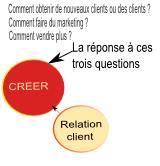In the company, different techniques can be used to determine how to adjust the resources. Among them, an essential technique stands. It is based on a reflection on the strengths, weaknesses, opportunities and threats of a company or organization. It commonly called SWOT analysis or SWOT matrix.
The SWOT analysis derived from the acronym (strength – Weaknesses – Opportunities – Threats) is a useful technique for, on the one hand, to understand your strengths and weaknesses and on the other hand, to identify opportunities that are available to you in your market, as well as the threats you might encounter. What makes particularly powerful SWOT analysis it, is that with a little thought, you can discover the opportunities of the market to operate and understand the weaknesses of your company to compensate, then eliminate, threats that could take you by surprise. In addition, observing your practices and comparing them with those of your competitors through SWOT analysis, you can develop a strategy that allows you to distinguish you from your competitors, to compete with them and overcome successfully in your market.
To discover in detail what is the SWOT analysis how to make your own, in chapter II, you will start with the introduction to SWOT analysis, in which are discussed: the definition of SWOT analysis, why it is important, its advantages and its profits, when to use it, its limits.
Chapter III focuses on the rules to be followed in conducting a SWOT analysis. Indeed, it is so simple, that it could be driving lightly and do not provide the desired result. But that is not all. You will discover also, in this chapter, different applications of this grid of analysis in business and which may be affected by such a SWOT analysis.
Once you learn more about the general appearance of the SWOT analysis, you will address in chapter IV how to prepare before making your SWOT analysis in chapter v.
Any job well done through a validation step. Your SWOT analysis grid will not escape. It is in chapter VI you will discover how to validate your SWOT analysis.
Finally, a SWOT analysis only makes sense if it is followed by a strategy. Here you will define your strategy, in two stages: first in Chapter VII, you will identify potential strategies to develop, then you will inspire you to set yours to Chapter VIII. You can also rely on the example of SWOT analysis provided in chapter IX and X to perfect your own analysis.









